2019 MERCEDES-BENZ CLA COUPE transmission
[x] Cancel search: transmissionPage 282 of 330
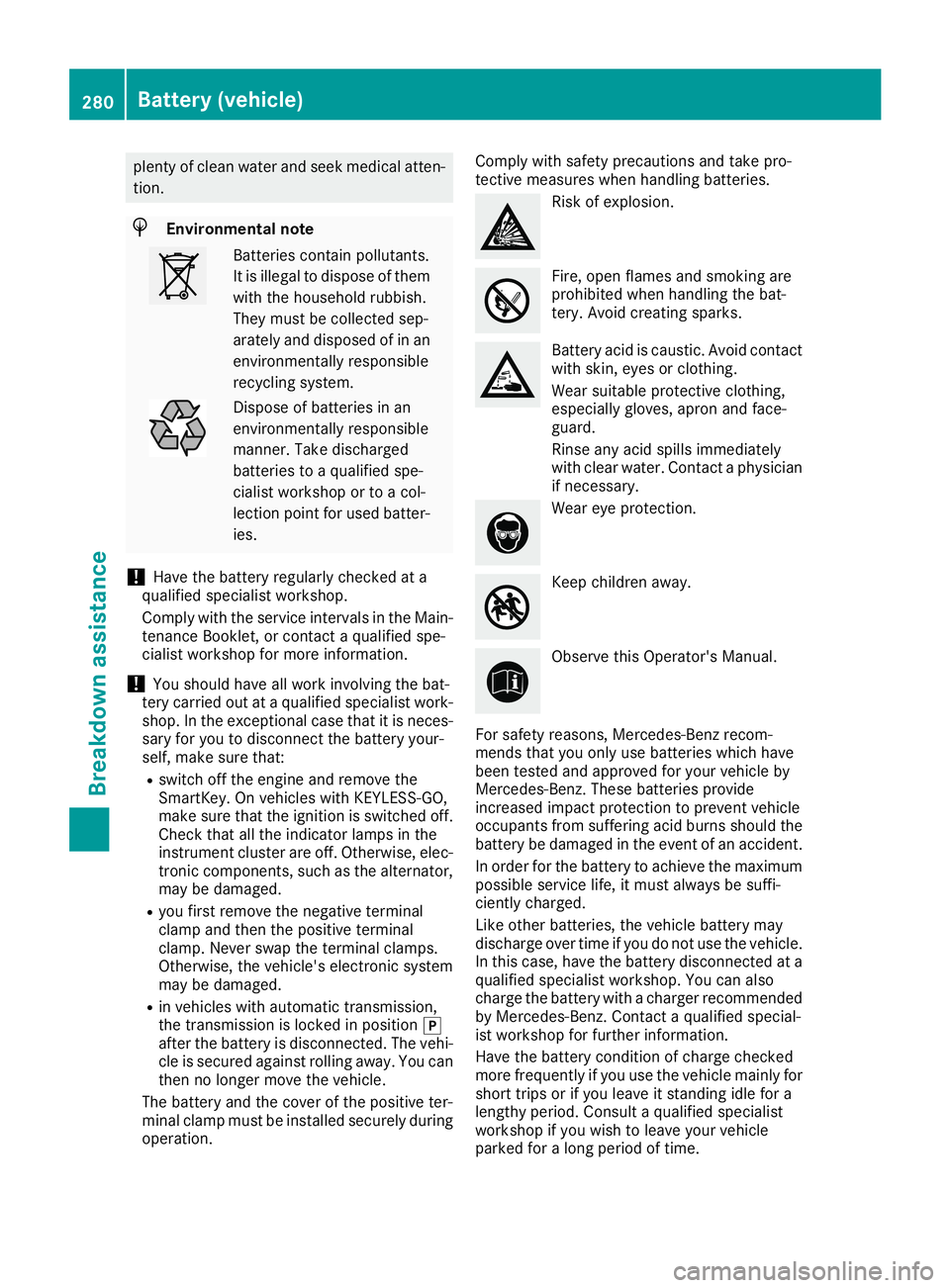
plent
yof clean water andseek medical atten-
tion . H
Environm
entalnote Batt
eries contain pollutant s.
It is illegal todispose ofthem
with thehousehold rubbish.
They must becollect edsep-
arately anddisposed ofinan
envir onmen tallyrespon sible
recyclin gsystem. Dispose
ofbatte riesinan
envir onmen tallyrespon sible
mann er.Take discharged
batte riestoaqualified spe-
cialist worksh oportoacol-
lection pointforused batter-
ies.
! Have
thebatte ryregularly checkedata
qualified specialist workshop.
Comply withtheservic eint ervals inthe Main-
ten ance Booklet,orcon tact aqualified spe-
cialist worksh opfor more information .
! You
should haveallwork involv ingthe bat-
tery carried outataqualified specialist work-
shop. Inthe exception alcase thatitis nec es-
sary foryou todiscon nectthe batte ryyour-
self, make surethat:
R switch offthe engin eand remov ethe
Smart Key.Onvehicles withKEYL ESS-GO,
make surethattheignit ionisswitch edoff.
Check thatallthe indicat orlamps inthe
inst rument clusterareoff. Other wise,elec-
tron iccompon ents,such asthe altern ator,
may bedamaged.
R you first remov ethe negat iveterm inal
clamp andthen thepositive terminal
clamp. Neverswaptheterm inalclamps.
Other wise, thevehicle's electronic system
may bedamaged.
R in vehicles withautomatic transmission ,
the tran smission islock edinposition 005D
after thebatte ryisdiscon nected. Thevehi-
cle issecured againstrollingaway.Youcan
then nolonger movethevehicle.
The batte ryand thecover ofthe positive ter-
minal clamp mustbeinst alled securely during
operation . Comply
withsafety precaution sand take pro-
tec tive measures whenhandling batteries. Risk
ofexplosion . Fire,
open flames andsmok ingare
prohibited whenhandling thebat-
tery. Avoid creatingsparks. Batt
eryacid iscaustic .Avoid contact
with skin,eyes orclot hing.
Wear suitable protective clot hing,
especially gloves,apronandface-
guard.
Rinse anyacid spills immediately
with clear water. Contac ta physician
if nec essary. Wear
eyeprote ction. Keep
children away. Observe
thisOperator 'sManual.
For safety reasons ,Mercedes -Benzrecom -
mends thatyouonly usebatte rieswhich have
been testedand approved foryour vehicle by
Mercedes -Benz.These batteriesprovide
incr eased impact protection topreven tvehicle
occ upants fromsufferin gacid burns should the
batte rybe damaged inthe event ofan acciden t.
In order forthe batte ryto achieve themaximum
possible servicelife, itmust always besuffi-
cient lycharged.
Like other batteries,thevehicle batterymay
discharge overtime ifyou donot use thevehicle.
In this case, havethebatte rydiscon nected ata
qualified specialist workshop.You canalso
charge thebatte rywith acharger recommended
by Mercedes -Benz.Contac ta qualified special-
ist worksh opfor furth erinfor mation .
Have thebatte rycon dition ofcharge checked
more frequent lyifyou usethevehicle mainlyfor
short tripsorifyou leave itstan ding idlefora
lengt hyperiod. Consult aqualified specialist
worksh opifyou wish toleave yourvehicle
parked foralong period oftime. 280
Ba
ttery (vehicle)Breakd ownassista nce
Page 285 of 330
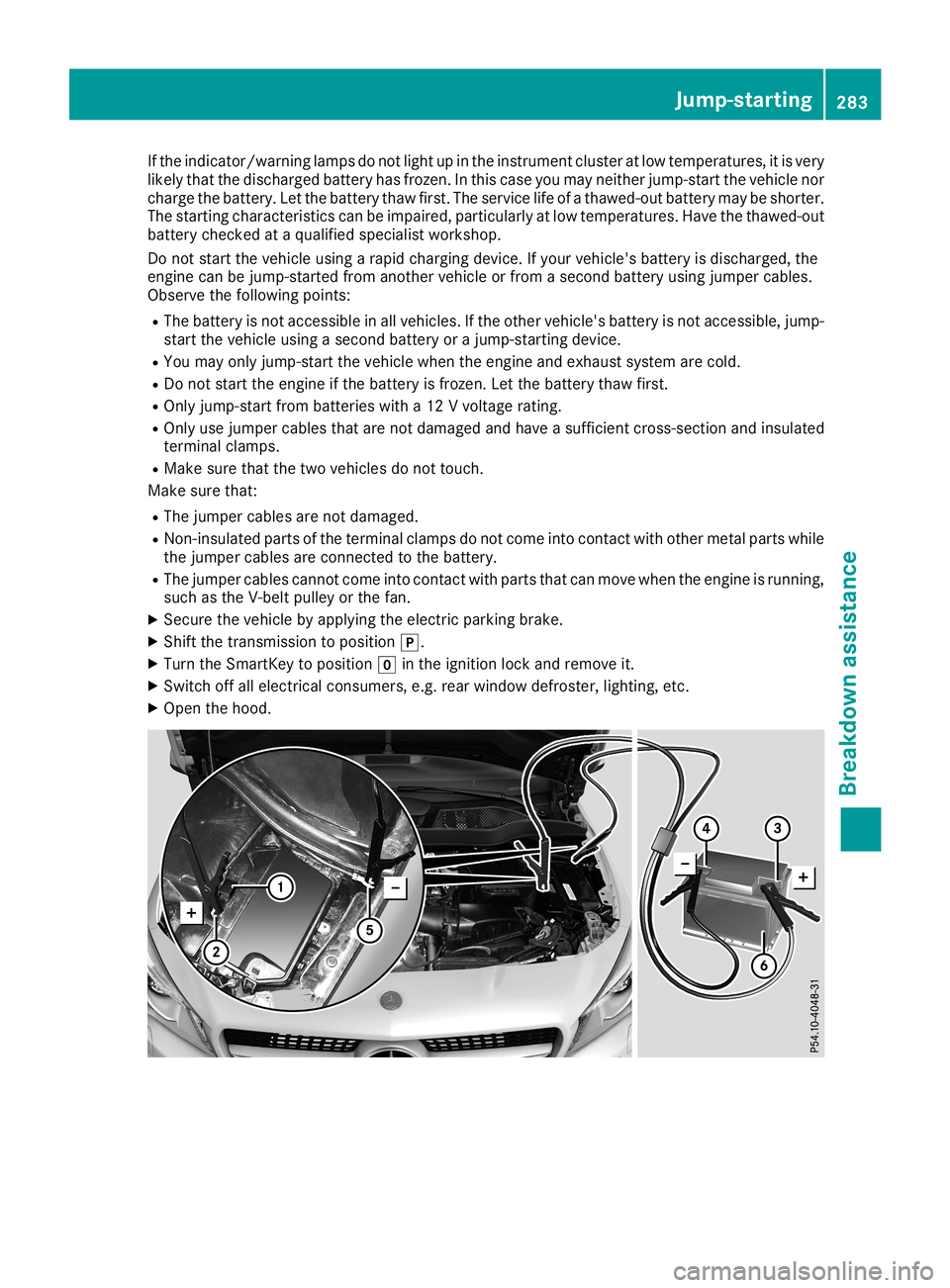
If
the indicator/wa rninglampsdo not light upinthe instrument clusteratlow temperature s,itis very
likely thatthedischa rgedbattery hasfrozen. Inthis case youmay neither jump-start thevehicle nor
charge thebattery. Letthe battery thawfirst.Theservice lifeofathawed -outbattery maybeshorter.
The starting characteristics canbeimpa ired,particul arlyatlow temperature s.Have thethawed -out
battery checked ataqua lifiedspecia listworkshop.
Do not start thevehicle usingarapi dcharging device.Ifyou rvehicle 'sbattery isdischa rged,the
engine canbejump-started fromanother vehicleorfrom asecond batteryusingjumper cables.
Observe thefollow ingpoints:
R The battery isnot accessib lein all vehicle s.Ifthe other vehicle 'sbattery isnot accessib le,jump-
start thevehicle usingasecond batteryorajump-starting device.
R You may onlyjump-start thevehicle whentheengine andexhau stsystem arecold.
R Do not start theengine ifthe battery isfrozen. Letthe battery thawfirst.
R Only jump-start frombatteries witha12 Vvoltage rating.
R Only usejumper cablesthat arenot dama gedand have asufficie ntcross-section andinsula ted
terminal clamps.
R Make surethatthetwo vehicle sdo not touch.
Make surethat:
R The jumper cablesare not dama ged.
R Non-insula tedparts ofthe terminal clampsdonot come intocontact withother metal partswhile
the jumper cablesare connected tothe battery.
R The jumper cablescannot comeintocontact withparts thatcanmove whentheengine isrunning,
such asthe V-belt pulley orthe fan.
X Secure thevehicle byappl ying theelectric parking brake.
X Shift thetransmission topositio n005D.
X Turn theSmartKey topositio n005A inthe ignition lockandremove it.
X Switch offallelectrical consumers, e.g.rear window defroster, lighting,etc.
X Open thehood. Jump-st
arting
283Breakd ownassis tance Z
Page 287 of 330
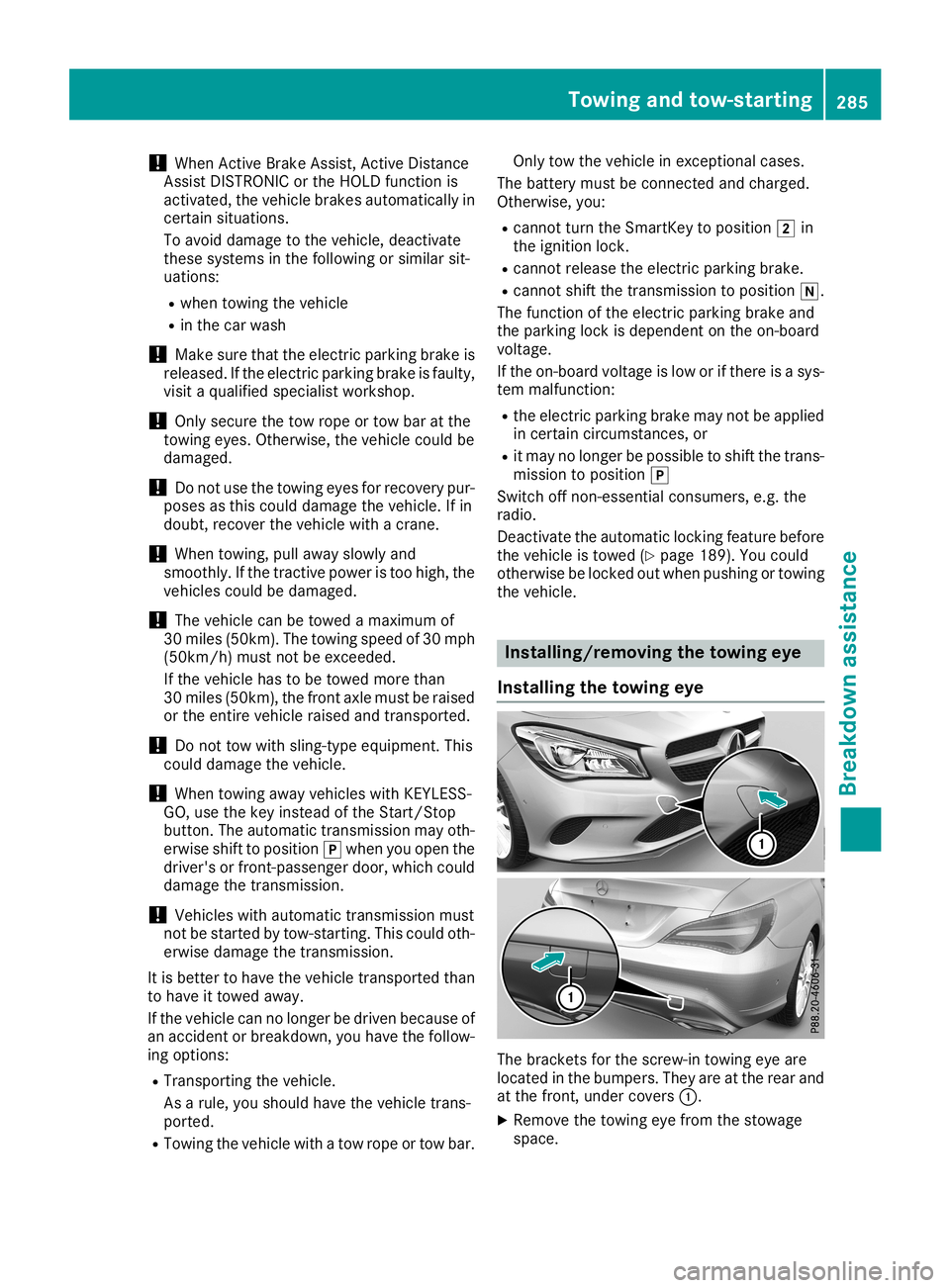
!
When
Active Brake Assist, Active Distance
Assist DISTRONIC orthe HOLD function is
activated, thevehicle brakesautomaticall yin
certain situations.
To avoid damage tothe vehicle, deactivate
these systems inthe followi ngorsimila rsit-
uations:
R when towing thevehicle
R in the carwash
! Make
surethattheelectric parking brakeis
released .If the electric parking brakeisfaulty,
visit aqual ified speciali stworkshop.
! Only
secure thetow rope ortow baratthe
towing eyes.Otherwise, thevehicle couldbe
damage d.
! Do
not use thetowing eyesforrecovery pur-
poses asthis could damage thevehicle. Ifin
doubt, recover thevehicle withacrane.
! When
towing, pullawayslowly and
smoothly. Ifthe tractive poweristoo high, the
vehicles couldbedamage d.
! The
vehicle canbetowed amaximum of
30 miles (50km). Thetowing speedof30 mph
(50km/h) mustnotbeexceeded.
If the vehicle hastobe towed morethan
30 miles (50km), thefront axlemust beraised
or the entire vehicle raisedandtransported.
! Do
not tow with sling-type equipment. This
could damage thevehicle.
! When
towing awayvehicles withKEYLES S-
GO, usethekey instead ofthe Start/ Stop
button. Theautomatic transmission mayoth-
erwise shifttoposition 005Dwhen youopen the
driver's orfront -passenger door,which could
damage thetransmission.
! Vehicles
withautomatic transmission must
not bestarted bytow-start ing.This could oth-
erwise damage thetransmission.
It is better tohave thevehicle transported than
to have ittowed away.
If the vehicle cannolonger bedriven because of
an accident orbreakdown, youhave thefollow-
ing options:
R Transporting thevehicle.
As arule, youshould havethevehicle trans-
ported.
R Towing thevehicle withatow rope ortow bar. Only
towthevehicle inexceptional cases.
The battery mustbeconnec tedand charged.
Otherwise, you:
R cannot turntheSmartKey toposition 0048in
the ignition lock.
R cannot release theelectric parking brake.
R cannot shiftthetransmission toposition 005C.
The function ofthe electric parking brakeand
the parking lockisdependent onthe on-board
voltage.
If the on-board voltageislow orifthere isasys-
tem malfunction:
R the electric parking brakemaynotbeappli ed
in certain circumstances, or
R itmay nolonger bepossible toshift thetrans-
mission toposition 005D
Switch offnon- essential consumers, e.g.the
radio.
Deactivate theautomatic lockingfeaturebefore
the vehicle istowed (Ypage 189). Youcould
otherwise belocked outwhen pushing ortowing
the vehicle. Installin
g/removing thetowing eye
Installin gthe towing eye The
brackets forthe screw-in towingeyeare
located inthe bumpers. Theyareatthe rear and
at the front ,under covers 0043.
X Remove thetowing eyefrom thestowage
space. Towing
andtow-start ing
285Breakdown assistance Z
Page 288 of 330
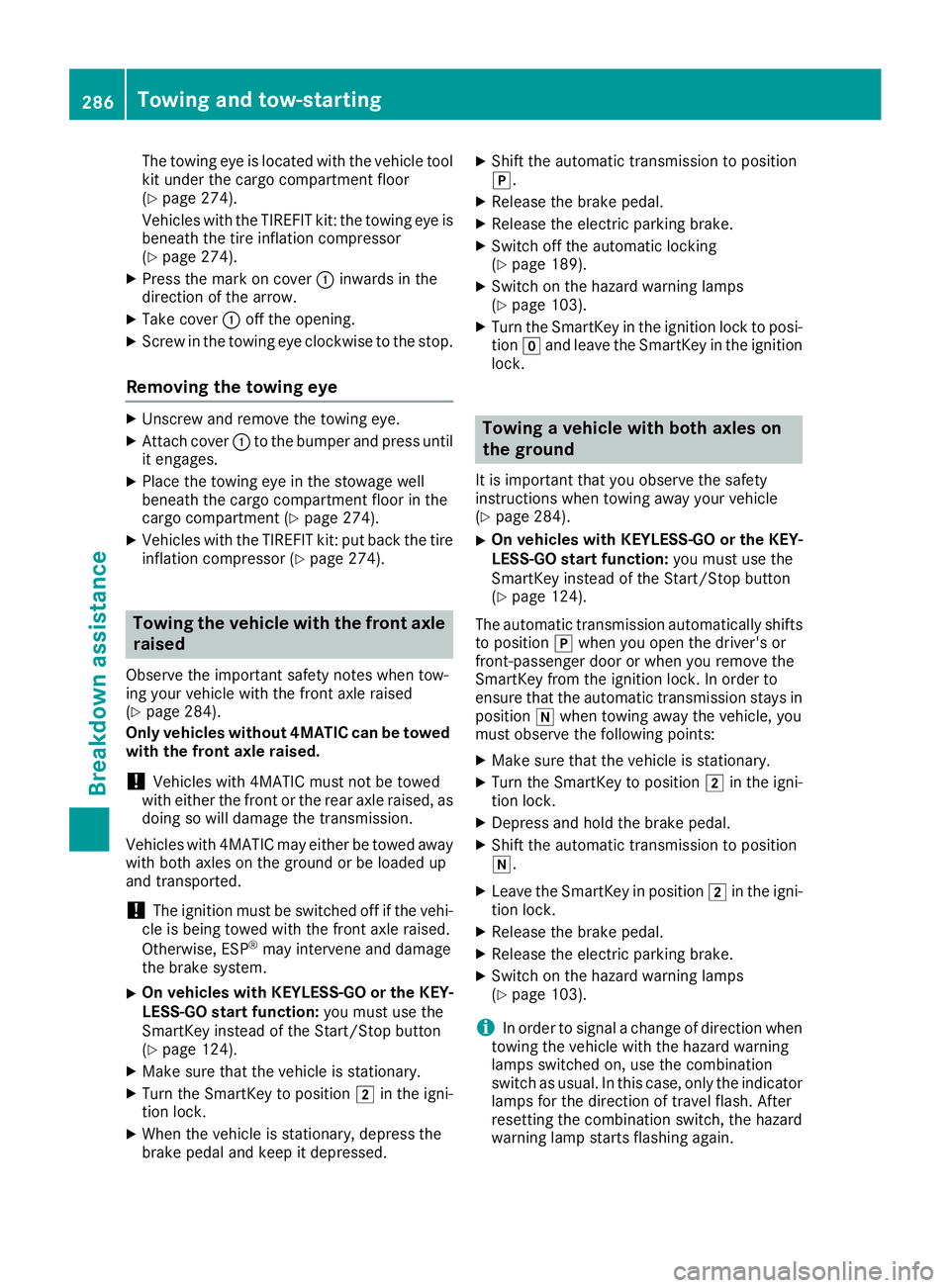
The
towing eyeislocated withthevehicle tool
kit under thecargo compart mentfloor
(Y page 274).
Vehicles withtheTIREFIT kit:the towing eyeis
beneath thetire inflation compressor
(Y page 274).
X Press themark oncover 0043inwards inthe
direction ofthe arrow.
X Take cover 0043offthe opening.
X Scr ewinthe towing eyeclock wisetothe stop.
Removing thetowing eye X
Unsc rewand remove thetowing eye.
X Attach cover 0043tothe bumper andpress until
it engages.
X Place thetowing eyeinthe stowage well
beneath thecargo compart mentfloorinthe
cargo compart ment(Ypage 274).
X Vehicles withtheTIREFIT kit:put back thetire
inflation compressor (Ypage 274). Towing
thevehicle withthefront axle
raised
Observe theimportant safetynoteswhen tow-
ing your vehicle withthefront axleraised
(Y page 284).
Only vehicles without4MATICcanbetowed
with thefront axleraised.
! Vehicles
with4MATI Cmust notbetowed
with either thefront orthe rear axle raised, as
doing sowill damage thetrans mission.
Vehicles with4MATI Cmay either betowed away
with both axles onthe ground orbe loaded up
and trans ported.
! The
ignition mustbeswitched offifthe vehi-
cle isbeing towed withthefront axleraised.
Otherwise, ESP®
may intervene anddamage
the brake system.
X On
vehicles withKEYL ESS-GO orthe KEY-
LESS-GO startfunction: youmust usethe
Smart Keyinstead ofthe Start /Stopbutton
(Y page 124).
X Make surethatthevehicle isstation ary.
X Turn theSmart Keytoposition 0048inthe igni-
tion lock.
X When thevehicle isstation ary,depress the
brake pedalandkeep itdepressed. X
Shift theautomatic transmission toposition
005D.
X Release thebrake pedal.
X Release theelectric parking brake.
X Switch offthe automatic locking
(Y page 189).
X Switch onthe hazard warning lamps
(Y page 103).
X Turn theSmart Keyinthe ignition locktoposi-
tion 005Aand leave theSmart Keyinthe ignition
lock. Towing
avehicle withboth axles on
the ground
It is important thatyouobserve thesafety
instr uctions whentowing awayyourvehicle
(Y page 284).
X On
vehicles withKEYL ESS-GO orthe KEY-
LESS-GO startfunction: youmust usethe
Smart Keyinstead ofthe Start /Stopbutton
(Y page 124).
The automatic transmission automatically shifts
to position 005Dwhen youopen thedriver's or
front -passenger doororwhen youremove the
Smart Keyfrom theignition lock.Inorder to
ensure thattheautomatic transmission staysin
position 005Cwhen towing awaythevehicle, you
must observe thefollowing points:
X Make surethatthevehicle isstation ary.
X Turn theSmart Keytoposition 0048inthe igni-
tion lock.
X Depress andhold thebrake pedal.
X Shift theautomatic transmission toposition
005C.
X Leave theSmart Keyinposition 0048inthe igni-
tion lock.
X Release thebrake pedal.
X Release theelectric parking brake.
X Switch onthe hazard warning lamps
(Y page 103).
i In
order tosignal achange ofdirection when
towing thevehicle withthehazard warning
lamps switched on,use thecombinat ion
switch asusual. Inthis case, onlytheindicator
lamps forthe direction oftravel flash.After
resett ingthe combinat ionswitch, thehazard
warning lampstartsflashing again. 286
Towing
andtow-sta rtingBr eakdown assistance
Page 289 of 330
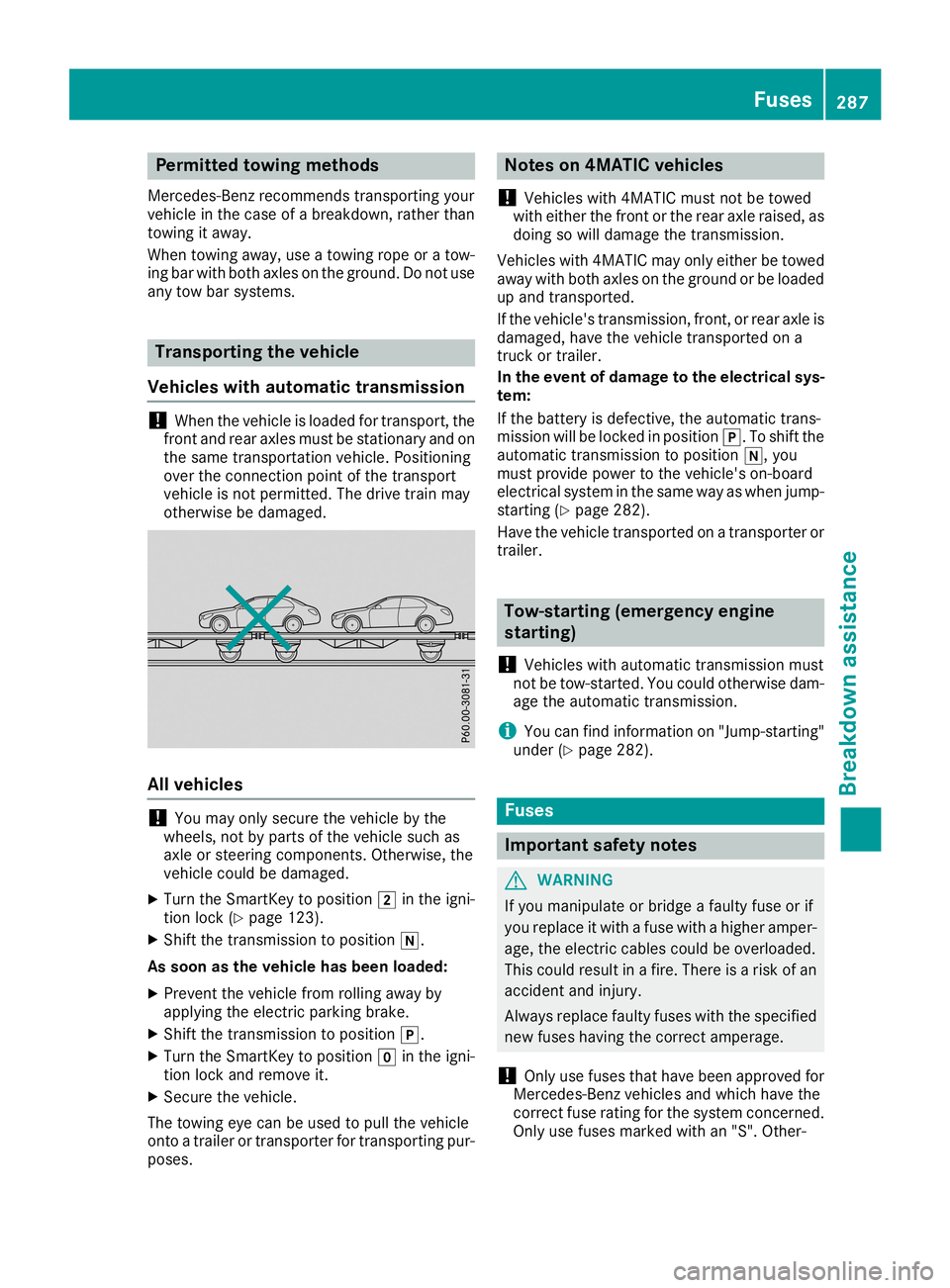
Permit
tedtowing method s
Mercedes-B enzrecommen dstransport ingyour
vehicle inthe case ofabreakdown, ratherthan
towing itaway .
When towing away,use atowing ropeoratow-
ing bar with both axles onthe ground. Donot use
any tow barsystems. Tr
ansport ingthe vehicle
Vehicles withautom atictransmission !
When
thevehicle isloaded fortransport ,the
front andrear axles mustbestationary andon
the same transport ationvehicle. Positioning
over theconn ection pointofthe transport
vehicle isnot permitted. Thedrive trainmay
otherwise bedamaged. All
vehicle s !
You
may onlysecure thevehicle bythe
wheels, notbyparts ofthe vehicle suchas
axle orsteering componen ts.Otherwise, the
vehicle couldbedamaged.
X Turn theSmartK eytoposition 0048inthe igni-
tion lock (Ypage 123).
X Shift thetransm issiontoposition 005C.
As soon asthe vehicle hasbeen loaded:
X Prevent thevehicle fromrolling awayby
apply ingthe electric parking brake.
X Shift thetransm issiontoposition 005D.
X Turn theSmartK eytoposition 005Ainthe igni-
tion lock andremove it.
X Secure thevehicle.
The towing eyecan beused topull thevehicle
onto atrailer ortransport erfor transport ingpur-
poses. Notes
on4MATIC vehicles
! Vehicles
with4MATIC mustnotbetowed
with either thefront orthe rear axle raised, as
doing sowill damage thetransm ission.
Vehicles with4MATIC mayonlyeither betowed
away withboth axles onthe ground orbe loaded
up and transport ed.
If the vehicle's transmission,front,or rear axle is
damaged, havethevehicle transport edon a
truck ortrailer.
In the event ofdam agetothe elec trical sys-
tem:
If the battery isdefective, theautomatic trans-
mission willbelocked inposition 005D.Toshift the
automatic transmissiontoposition 005C,you
must provide powertothe vehicle's on-board
electrical systeminthe same wayaswhen jump-
startin g(Y page 282).
Have thevehicle transport edon atransport eror
trailer. Tow-star
ting(emergency engine
star ting)
! Vehicles
withautomatic transmissionmust
not betow-st arted. Youcould otherwise dam-
age theautomatic transmission.
i You
canfind information on"Jump-starting"
under (Ypage 282). Fuses
Import
antsafety notes G
WARNING
If you manipulate orbridge afaulty fuseorif
you replace itwith afuse withahigher amper-
age, theelectric cablescouldbeoverloaded.
This could result inafire. There isarisk ofan
accident andinjury.
Always replace faultyfuseswiththespecified
new fuses having thecorrect amperage.
! Only
usefuses thathave been approved for
Mercedes-B enzvehicles andwhich havethe
correct fuserating forthe system concerned.
Only usefuses marked withan"S". Other- Fuses
287Breakdown assistance Z
Page 320 of 330

The
maximum transmission output(PEAK)at the
base ofthe anten namust notexceed thefol-
lowing values: Frequency
band Maximu
m
tra nsmission
outpu t Short
wave
3 -54 MHz 100
W 4
m waveband
74 -88 MHz 30
W 2
m waveband
144 -174 MHz 50
W Trunked
radiosystem/
Tetra
380 -460 MHz 10
W 70
cm waveband
400 -460 MHz 35
W Mobile
commun ications
(2G/3G/4G) 10
W The
following canbeused inthe vehicle without
restr iction s:
R RF trans mitterswith amaximum transmis-
sion output ofup to100 mW
R RF trans mitterswith trans mitterfrequencies
in the 380 -410 MHz frequency bandanda
maximum transmission outputofup to2W
(trunk edradio system/Tet ra)
R Mobile phones (2G/3G/4G)
There isno restr iction foranten napositions on
the outside ofthe vehicle forthe following fre-
quency bands:
R Trunked radiosystem/Tet ra
R 70 cm waveband
R 2G/3G/4 G Identification
plates Vehicle
identification platewith vehi-
cle identification number(VIN) X
Open thedriver's door.
You willsee vehicle identific ationplate0043. Example:
vehicleidentific ationplate(USA only)
0043 VIN
0044 Paint code Example:
vehicleidentific ationplate(Canada only)
0043 VIN
0044 Paint code
i The
data shown onthe vehicle identific ation
plate isused onlyasan example. Thisdata is 318
Identification
platesTechnical data